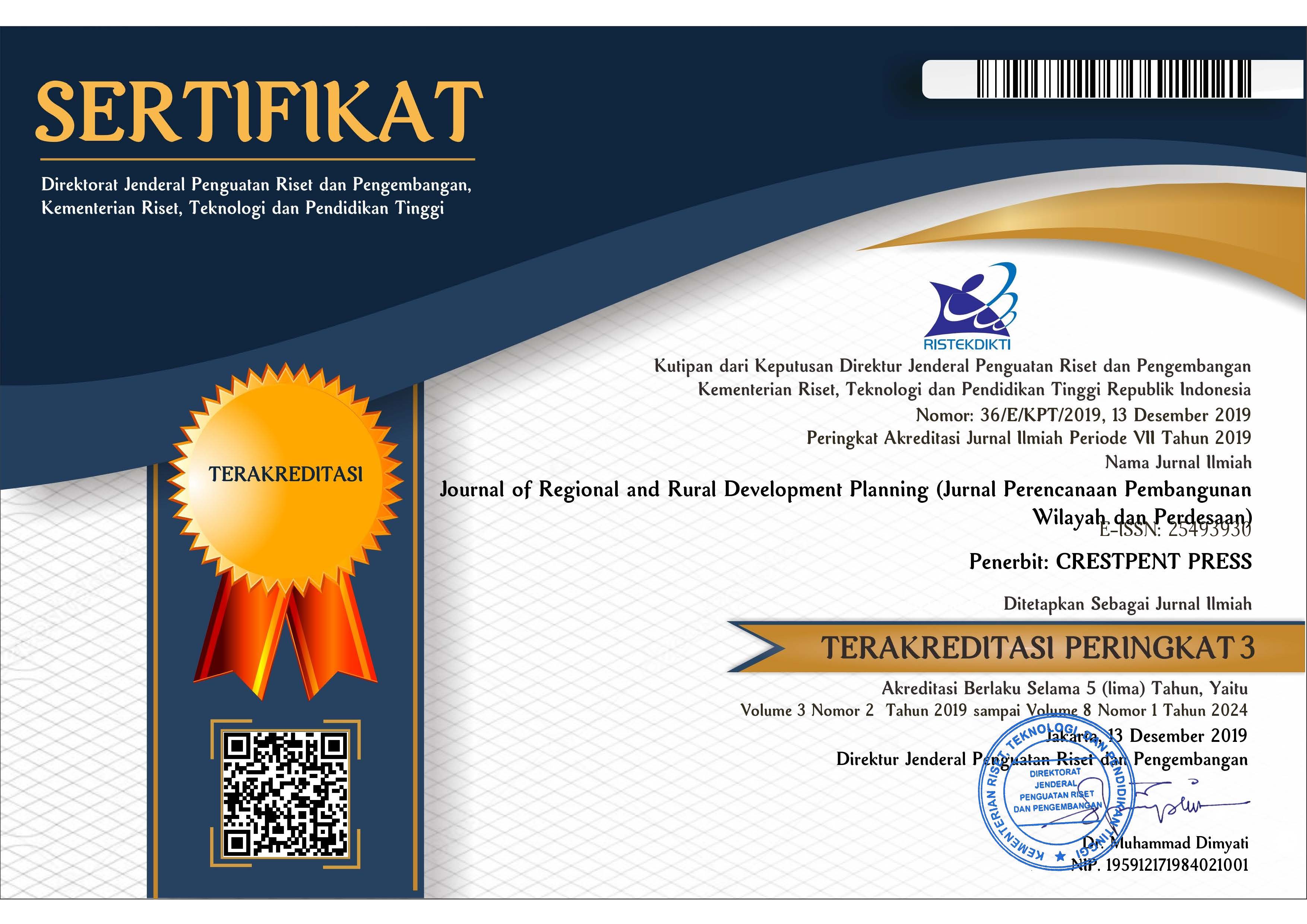Ketimpangan Pembangunan Antarwilayah Pengembangan di Provinsi Papua Barat
Abstract
Regional-based development aims to minimize the disparity between regions. Local government of West Papua province divides its region into three development regions (WP), namely (1) Teluk Bintuni, Manokwari, and Teluk Wondama; (2) Maybrat, Raja Ampat, Sorong Regency, Sorong Municipality, South Sorong, and Tambrauw; (3) Fakfak and Kaimana. Each development region has different characteristics from each other. These differences include regional typology (coastal and mountainous), population (under 50 thousand inhabitants, 50-100 thousand inhabitants, and above 100 thousand inhabitants), and administrative status (old districts and new autonomous regions). The purpose of this research is to analyze local typologies and the factors that affect the disparity between development regions in West Papua province by using panel data regression. Analysis technique used are local typologies, Theil Index and panel data regression. Research results show that there are no regions that are dominant in the first quadrant (advanced) and fourth quadrant (underdeveloped) of Klassen typology. Theil Index value, which represents disparity, shows an increasing trend. Variables that affect positively to the Theil Index are length of road, locally-generated revenue, dummy on the absence of the city, dummy on ethnic region, and average expenditure per capita. Meanwhile variables that affect negatively and significantly to the Theil Index are the share of natural resources and dummy on the absence of new autonomous regions.
References
Adinugroho, G. (2017). Hubungan Perkembangan Wisata terhadap Ekonomi Wilayah di Gunungkidul Selatan. Journal of Regional and Rural Development Planning, 1 (1), 16-27. doi: http://dx.doi.org/10.29244/jp2wd. 2017.1.1.16-27
Apriana, D. & Suryanto, R. (2010). Analisis Hubungan Antara Belanja Modal, Pendapatan Asli Daerah, Kemandirian Daerah Dan Pertumbuhan Ekonomi Daerah (Studi Pada Kabupaten Dan Kota Se Jawa-Bali). Jurnal Akuntansi & Investasi, 11 (1), 68-79.
Ardila, R. (2012). Analisis Pengembangan Pusat Pertumbuhan Ekonomi Di Kabupaten Banjarnegara. Economics Development Analysis Journal, 1(2),1-9. https://doi.org/10.15294/edaj.v1i2.482
Baransano, M.A., (2011). Analisis Disparitas Pembangunan Wilayah di Provinsi Papua Barat. Thesis. Institut Pertanian Bogor.
Bhattacharyya, S., & Hodler, R. (2014). Do Natural Resource Revenues Hinder Financial Development? The Role of Political Institutions. World Development, 57, 13. doi: http://dx.doi.org/10.1016/j.worlddev.2013.12.003
Brotodewo, N. (2010). Penilaian Indikator Transportasi Berkelanjutan pada Kawasan Metropolitan di Indonesia. Jurnal Perencanaan Wilayah dan Kota, 21 (3), 165-182.
[BPS] Badan Pusat Statistik. (2017). Kabupaten dalam Angka 2016.
[BPS] Badan Pusat Statistik. (2016). Papua Barat Dalam Angka 2016.
[BPS] Badan Pusat Statistik. (2017). Statistik Keuangan Daerah 2015-2016.
Djakapermana, R. D., (2013). Pengembangan Wilayah: Melalui Pendekatan Kesisteman. Bogor: IPB Press.
Enflo, K., Alvarez-Palau, E., & Marti-Henneberg, J. (2018). Transportation and regional inequality: the impact of railways in the Nordic countries, 1860-1960. Journal of Historical Geography, 62, 51-70.
Fan S, Kanbur R, Zhang X. 2011. China’s regional disparities: Experience and policy. Review of Development Finance, 1, 47-56. doi:10.1016/j.rdf.2010.10.001.
Goschin, Z. (2014). Regional growth in Romania after its accession to EU: a shift-share analysis approach. Procedia Economics and Finance, 15, 169–175 doi: https://dx.doi.org/10.1016/S2212-5671(14)00471-7
Karath, M. (2015). Accelerating The Development For The Welfare Community In The Land Of Papua. Global Journal of Arts Humanities and Social Sciences, 3 (3), 30-43.
Kuncoro, M. (2004). Otonomi dan Pembangunan Daerah: Reformasi, Perencanaan, Strategi dan Peluang. Jakarta: Penerbit Erlangga.
Latuconsina, Z. M. Y. (2017). Analisis Faktor-faktor yang Mempengaruhi Indeks Pembangunan Manusia Kabupaten Malang Berbasis Pendekatan Perwilayahan dan Regresi Panel. Journal of Regional and Rural Development Planning, 1 (2), 202-216. doi:http://dx.doi.org/10.29244/jp2wd.2017.1.2.202-216
Mahardiki, D. dan Santoso, R.P., (2013). Analisis Perubahan Ketimpangan Pendapatan dan Pertumbuhan Ekonomi Antar Provinsi di Indonesia 2006-2011. Journal of Economics and Policy, 6 (2),103-213. doi: http://dx.doi.org/10. 15294/jejak.v7i1.3596
Malik, A. S. (2014). Analisis Konvergensi Antar Provinsi Di Indonesia Setelah Pelaksanaan Otonomi Daerah Tahun 2001-2012. Journal of Economics and Policy, 7 (1), 92-101. doi: dx.doi.org/10.15294/jejak.v7i2.3846
Mawarni, Darwanis, Abdullah Syukriy. 2013. Pengaruh Pendapatan Asli Daerah Dan Dana Alokasi Umum Terhadap Belanja Modal Serta Dampaknya Terhadap Pertumbuhan Ekonomi Daerah (Studi Pada Kabupaten Dan Kota Di Aceh). Jurnal Akuntansi Pascasarjana Universitas Syiah Kuala, 2 (.2), 80-90. ISSN 2302-0164 http://prodipps. unsyiah.ac.id/Jurnalmia/images/Jurnal/2013/2.akuntansi.vol2.no2.mei.2013/9.[80-90].Mawarni.pdf
Nurhadi. (2012). Konsep Perwilayahan Dan Teori Pembangunan Dalam Geografi. Geomedia, 10 (1), 49-66. https://journal.uny.ac.id/index.php/geomedia/article/view/3595/3071
Oktaviana, M. G., Sulistio, H., & Wicaksono, A. (2011). Strategi Pengembangan Antar Wilayah Di Provinsi Papua Barat. Jurnal Rekayasa Sipil, 5 (3), 180-190. ISSN 1978 – 5658. http://Rekayasasipil. Ub.Ac.Id/Index.Php/Rs/Article/View/204/197
Oluwole, O. A., & Daful, N. G. (2014). Characterization of Jos City Road Network, Nigeria. Indonesian Journal Of Geography, 46 (2), 177-186. ISSN 0024-9521. https://jurnal.ugm.ac.id/ijg/ article/view/6078/4829
Putri, A. D., & Dartanto, T. 2016. Dekomposisi Perubahan Ketimpangan di Indonesia Tahun 2005-2014. JESP, 8 (1), 72-91.
Rustiadi, E., Saefulhakim, S., & Panuju, D. R. (2011). Perencanaan dan Pengembangan Wilayah. Cetakan Ketiga. Yayasan Pustaka Obor Indonesia.
Sihaloho, A., Jinca, M. Y., Wunas, S., Parung, Herman. (2012). Ferry Transport of Trans Maluku Antaraislands Cluster In Indonesia Antaranational Journal Of Civil & Environmental Engineering Ijcee-Ijens, 12 (5), 9-14.
Soares, L., Rustiadi, E., & Mulatsih, S. (2017). Analisis Disparitas dan Antaraaksi Spasial di Timor–Leste. Journal of Regional and Rural Development Planning, 1 (1), 74-86. doi: https://dx.doi.org/10.29244/ jp2wd.2017.1.1.74-86
Thakura, R., & Sangara, S. (2015). Increasing Inequality in the Western Indian Himalayan Region. Procedia Economics and Finance, 30, 910-922. doi: https://doi.org/10.1016/S2212-5671 (15) 01341-6
Vickerman, R. (2015). High-speed rail and regional development: the case of antaramediate stations. Journal of Transport Geography, 42, 157-165. doi: http://dx.doi.org/10.1016/j. jtrangeo.2014.06.008
Wanga, S., Fua, B., Chen, H., & Liu, Y. (2018). Regional development boundary of China’s Loess Plateau: Water limit and land shortage. Land Use Policy, 74, 130-136. doi: https://doi.org/10.1016/ j.landusepol.2017.03.003
Yeniwati. (2013). Ketimpangan Ekonomi Antar Provinsi Di Sumatera. Jurnal Kajian Ekonomi, 2 (3), 1-21. ISSN 2301-4288. http://ejournal.unp.ac.id/ index.php/ekonomi/article/view/2734/2332
Copyright (c) 2018 Journal of Regional and Rural Development Planning

This work is licensed under a Creative Commons Attribution-ShareAlike 4.0 International License.




.png)














